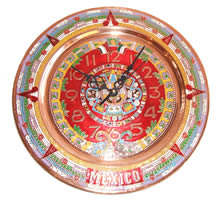ANALYSIS OF TIME IN “SISTER STORIES”
About the time in “Sister Stories” I
have decided to work in the period of time of the Aztecs
because the story talk about this ancient culture, talk about a family
of cents of years ago in an Aztec city in Mexico.
This is to say that this story is situated before the s. XIV.
 Aztecs were a wandering Native American tribe
who came to Mexico during the 13th century. There they built a great
civilization including cities, pyramids, and temples. In 1519 Spanish
conquistadors arrived in Mexico and defeated the Aztecs.
Aztecs were a wandering Native American tribe
who came to Mexico during the 13th century. There they built a great
civilization including cities, pyramids, and temples. In 1519 Spanish
conquistadors arrived in Mexico and defeated the Aztecs.
Aztec History begins with the Aztecs
legendary home called Aztlan. The general consent is that Aztlan lies somewhere
to the north of the Valley of Mexico. But there are also Aztec history experts
that claim that Aztlan is simply a mythical place where the Aztec tribes came
from. The reason that some Aztec historians think so lies in the fact that
Aztlan can also be translated as "the place of the origin". According
to Aztec history there were seven Aztec Tribes that lived
under opression in Aztlan. They all eventually fled from Aztlan to the south.
Aztec history legend goes that years
later (1323) Mexica tribe saw a vision from their Aztec Gods that made them
move again. The vision was of an eagle perched on cactus, clutching a snake.
This vision showed the Mexica tribe where they should build their new city. So
the tribe of Mexicas actually moved to a small island in Lake Texcoco (where
the story took place) and started building a new home - the city of Tenochtitlan.
Later in 1376 they elected their first ruler (their word for king was Huey
Tlatoani) Acamapichtli.
The center of the Aztec civilization was
the Valley of Mexico, a huge, oval basin about 7,500 feet above sea level. The
Aztec empire included many cities and towns, especially in the Valley of
Mexico. The largest city in the empire was the capital, Tenochtitlan. The early
settlers built log rafts, then covered them with mud and planted seeds to
create roots and develop more solid land for building homes in this marshy
land. Canals were also cut out through the marsh so that a typical Aztec home
had its back to a canal with a canoe tied at the door.
There were several Aztecs in several
places, but we have to focus in the Aztecs of Mexico:
The Aztecs/Mexicas were the native
American people who dominated northern México at the time of the Spanish
conquest led by Hernan CORTES in the early 16th century. According to their own
legends, they originated from a place called Aztlan, somewhere in north or
northwest Mexico. At that time the Aztecs (who referred to themselves as the
Mexica or Tenochca) were a small, nomadic, Nahuatl-speaking aggregation of
tribal peoples living on the margins of civilized Mesoamerica. Sometime in the
12th century they embarked on a period of wandering and in the 13th century
settled in the central basin of México. Continually dislodged by the small
city-states that fought one another in shifting alliances, the Aztecs finally
found refuge on small islands in Lake Texcoco where, in 1325, they founded the
town of TENOCHTITLAN (modern-day Mexico City). The term Aztec, originally
associated with the migrant Mexica, is today a collective term, applied to all
the peoples linked by trade, custom, religion, and language to these founders.
History of Aztecs (available
in “Sister Stories):
 The
construction of 'histories' for the Aztec has been one of the major topics of
modern scholarship of late pre-European Mexico. Taking literally accounts that
are infused with mythical
symbolism, scholars like Nigel Davies
arrived at a consensus history:
The
construction of 'histories' for the Aztec has been one of the major topics of
modern scholarship of late pre-European Mexico. Taking literally accounts that
are infused with mythical
symbolism, scholars like Nigel Davies
arrived at a consensus history:
AD 1111 The Mexica
leave Aztlan,
their mythical homeland,
the last of seven peoples to begin wandering
AD 1163 They celebrate the New
Fire ceremony at Coatepec,
marking the end of a 52 year Calendar
Round on their journey
AD 1215 They celebrate the New Fire ceremony at Apaxco
AD 1267 They celebrate the New Fire ceremony at Tecpayocan
AD 1299 The Mexica arrive at Chapultepec
in the Valley
of Mexico
AD 1319 The Mexica are expelled from Chapultepec
AD 1343 The Mexica sacrifice a princess of Culhuacan
and flee
from the service of Culhuacan into the lake marshes
AD 1345 Tenochtitlan
is founded, where the Mexica see an eagle
perched on a cactus, the omen predicted by their god
ca. AD 1367 The Mexica serve as mercenaries for Tezozomoc
of the Tepanec
city, Atzcapotzalco
AD 1428 Conquest of Atzcapotzalco by Mexica and Texcocans
AD 1431 "Triple Alliance" formed by the Mexica of Tenochtitlan,
the Tepanecs of Tlacopan, and the Acolhua
of Texcoco
AD 1473 The Mexica conquer the neighboring city, Tlatelolco
AD 1500 The Mexica establish dominance over the Triple Alliance
by making Tlacopan a dependency
AD 1515 The Mexica install a puppet ruler in Texcoco
AD 1519 Hernan Cortes arrives at Tenochtitlan
AD 1521 Tenochtitlan surrenders to the armies of Cortes
This is the history of the Aztecs that
appear in “Sister Stories”, this is the “time” in which the family is situated.
Another thing that can be treated about
the time and that could be interesting is the “Aztec time”, or, the special Aztec calendar (the
story talk about it too):
The Calendar Round is the term
anthropologists use for the larger cycle of time in pre-hispanic Mexico. Like most
people throughout human history, the Mexica did not have a single linear
calendar with a fixed beginning date to time all events. Instead, they
supported multiple calendars: counts of the phases
of the moon and the planet venus, a solar calendar that also served to mark
the seasons and time the agricultural year, and a ritual calendar used for
divination, notably at birth,
whose length may have been an approximation of the period of human pregnancy.
All of these calendrical counts proceeded at the same time. Absolute dating
could be achieved by characterizing a particular time period and counting from
that: for example, events could be placed in the reign of a particular ruler.
But for most of Mesoamerican history, a combination of the solar and divinatory
calendars was used to create a 52-year-long calendar.
The solar
calendar, fixed by the number of days that elapsed between the same point
in the sun's movement on the horizon, was of course set at 365 days. The divinatory
calendar was 260 days long. When the two calendars started on the same day,
it took 52 years for them again to reach their beginning dates on the same day
to start a new cycle.
Well, here I have put some history of
the Aztec period in which “Sister Stories” is based, now, I’m going to put some
interesting links related with this culture and with this story, I think are
very useful, click here!
Academic year
2008/2009
© a.r.e.a./Dr.Vicente Forés López
© Elvira Mateo López
elmalo@alumni.uv.es
Universitat de València Press
Creada: 05/12/2008
Última Actualización: 09/12/2008